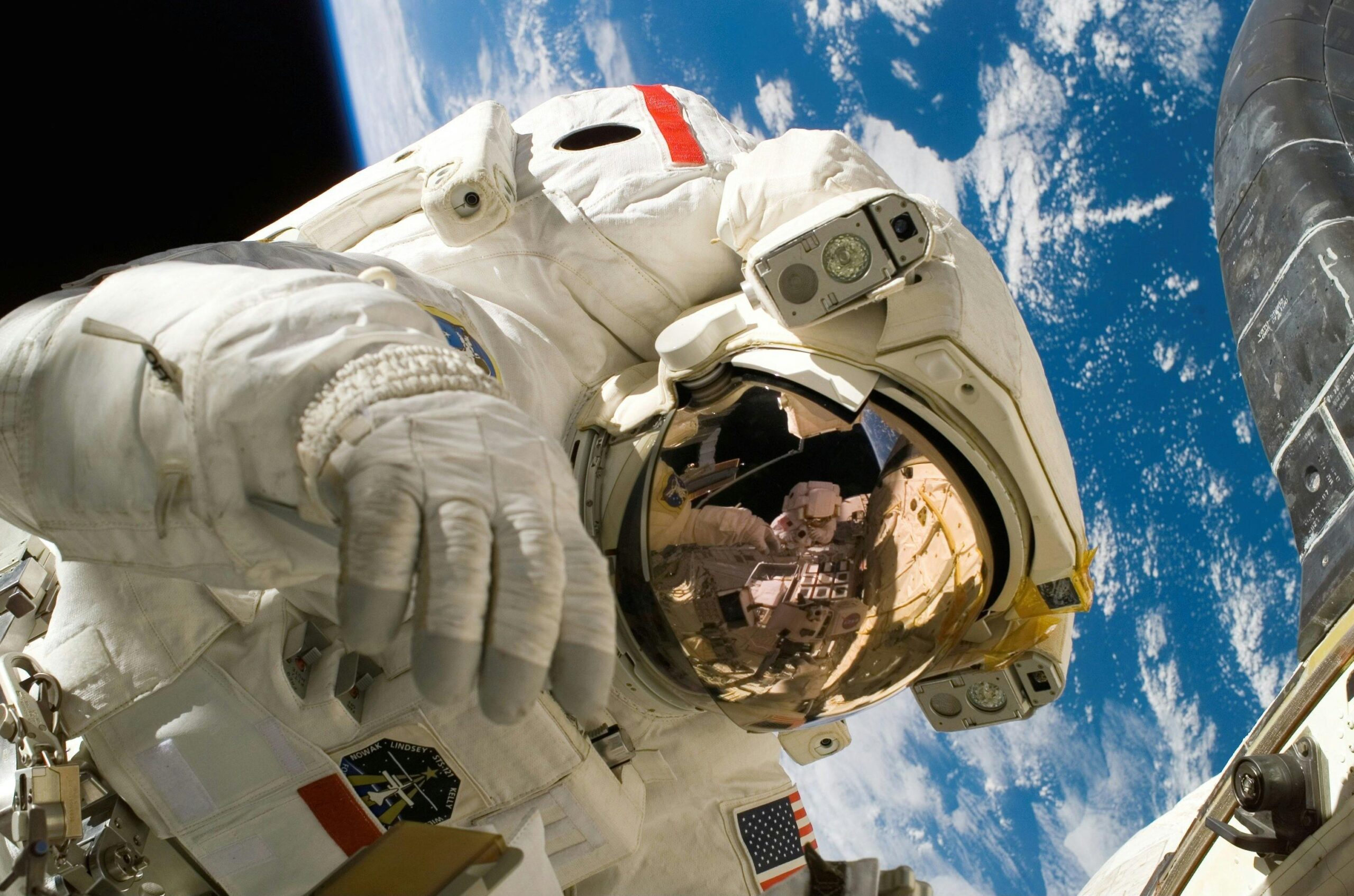Astronaut Shuts Down Flat Earth Theory Once and for All With Simple Camera Flip

There are beliefs that endure, no matter how many times the truth is laid bare. The Flat Earth theory is one of them. Despite centuries of irrefutable evidence, there are still those who hold fast to the idea that our planet is not a sphere, but a flat disc. It’s a strange and persistent belief, especially when we live in a world where space exploration and scientific advancements have proven beyond a doubt that the Earth is round.
But here’s the thing: it’s easy to believe in something when you don’t have to see it for yourself. We live in an age where misinformation spreads like wildfire, and where even the most outlandish theories find their place on social media. Platforms like Reddit, YouTube, and TikTok become breeding grounds for these ideas, creating a sense of community for those who feel skeptical of mainstream science.
So what happens when someone with firsthand knowledge of the truth—a person who’s actually seen the Earth from space—decides to speak up? What if, with a simple camera flip, they could put the debate to rest once and for all? This is exactly what one astronaut did, and in doing so, he not only proved the Earth’s roundness, but also offered a lesson in how seeing is believing.
Why People Cling to Flat Earth Theories

The mind is a powerful thing, and sometimes it has a way of clinging to beliefs—especially when they give us a sense of control or comfort. For many, the idea that the Earth is flat may seem far-fetched, but it is a deeply ingrained part of their worldview. It’s not just about rejecting science or education; it’s about rejecting the authority that comes with it. The conspiracy mentality, where everything is viewed through a lens of distrust, becomes a shield against uncomfortable truths.
You see, beliefs like these aren’t formed in a vacuum. They are influenced by emotions, experiences, and the desire to find a narrative that fits one’s sense of reality. And in the case of the Flat Earth theory, this belief has found fertile ground in a world increasingly fueled by misinformation and skepticism. The internet, with its vast, interconnected network, gives these fringe ideas a platform. It allows people to come together, creating echo chambers where doubt is not only encouraged but celebrated.
It’s easy to get lost in these communities, especially when the voices that challenge your beliefs are drowned out by the loud chorus of like-minded individuals. Flat Earth forums, videos, and social media discussions become a refuge for those who find comfort in the idea that the world is not as it seems. But why do people cling to these ideas, even when confronted with overwhelming evidence to the contrary?
Perhaps, it’s the human tendency to question authority. We all want to feel that we have control over our world. Questioning the very foundations of science and reality gives people a sense of power, of being “in the know.” It’s a form of resistance, an act of defiance against a system they perceive as being oppressive or dishonest. It can be a way to feel unique, special even—someone who is not fooled by mainstream narratives.
While it’s important to understand the psychology behind these beliefs, it’s equally important to acknowledge the consequences. Because in the end, these beliefs don’t just exist in isolation. They can lead to a rejection of other scientific truths, like climate change, or vaccines, or even historical events. And this widespread distrust in science can have dangerous consequences for society as a whole.
The Astronaut’s Simple yet Powerful Proof
@spacemanedu Someone Said Earth Was Flat… #space #fyp #viral #spacemanedu #astonaut #fy #flatearth ♬ original sound – 𝔍𝔞𝔨𝔢
In a world where words often fall on deaf ears, sometimes all it takes is a single, undeniable image to shatter long-held misconceptions. That’s exactly what happened when an astronaut, floating in the vast expanse of space, decided to settle the Flat Earth debate once and for all—simply with a camera flip.
It was a moment that sent shockwaves through social media: a video posted by an astronaut on TikTok showing the Earth in all its spherical glory. With a flick of his wrist, he turned the camera to reveal the curvature of our planet, unmistakable and undeniable. The video, shared on the page @spacemanedu, quickly went viral, amassing over six million likes as viewers from around the world saw for themselves the shape of the Earth they had long debated.
In a world where doubt and skepticism often cloud our judgment, this video offered clarity. The astronaut, armed with nothing but the view from space, made it clear that the Earth was not a flat disc as some had claimed, but a beautifully round sphere, hanging in the infinite black of space. The message was simple, yet profound: “Someone Said Earth Was Flat…” he wrote. And with that, the debate was visually and definitively put to rest—at least, for those willing to see it.
But the power of this proof lies not just in the image itself, but in the fact that it came from someone who had been there, someone who had experienced the truth firsthand. For many, the reality of space travel offers a kind of legitimacy that words and theories simply cannot. It’s one thing to hear about the shape of the Earth, but it’s another to see it with your own eyes. And for this astronaut, it was a moment of clarity that transcended all previous arguments.
The video didn’t just shut down the flat Earth theory; it also reminded us of something deeply important: sometimes, the truth doesn’t need to be debated—it simply needs to be shown.
A Century-Old Truth that Can’t Be Denied
The truth about the shape of the Earth isn’t new—it’s been known for centuries. The idea of a spherical Earth wasn’t born in the age of space exploration or even the telescope. It dates back to ancient Greek philosophers like Pythagoras, who theorized the Earth was round even before his death in 495 B.C. Their early observations laid the groundwork for what we now accept as a fundamental scientific truth.
Throughout history, this understanding only grew stronger. Aristotle, another ancient philosopher, noticed that the Earth cast a round shadow on the moon during a lunar eclipse—one of many key pieces of evidence. By the 3rd century B.C., the Greek mathematician Eratosthenes had even calculated the Earth’s circumference with remarkable accuracy, simply by comparing the angle of the sun’s rays at two different locations.
Fast forward to modern times, and space exploration has provided us with even more definitive proof. Astronauts, who have actually journeyed into space and seen the Earth with their own eyes, continue to refute the flat Earth theory. NASA astronaut Terry Virts famously responded to rapper B.o.B.’s flat Earth campaign in 2017 by saying, “I can save BoB a lot of money — the Earth is round. I flew around it.” It’s a simple, matter-of-fact statement from someone who has orbited the planet, providing firsthand evidence of its spherical shape.

Buzz Aldrin, the second person to walk on the moon, echoed Virts’ sentiment, explaining that the Earth’s curvature is visible from space, not just in photos, but during orbital flights as well. Fellow astronaut Scott Kelly took things even further when he shared a stunning time-lapse video from the International Space Station, showing the Earth’s curvature as it rotated beneath him. “Show you the curve?” he wrote. “Here you go @bobatl! One full orbit around Earth.”
These astronauts, along with countless other explorers and scientists, have provided a constant stream of visual and empirical evidence that should leave no room for doubt. And yet, the flat Earth theory persists, even in the face of overwhelming proof.
The question, then, is not whether the Earth is round—but why there are still some who refuse to accept it. The evidence has always been clear. We’ve always known. But some people continue to choose doubt over truth, making it all the more urgent for us to stand firm in our understanding and communicate the truth in ways that reach those who remain unconvinced.
Why Some Still Believe: Understanding Why Flat Earth Beliefs Persist

Even when the evidence is overwhelming, why do some still refuse to believe? Why does the Flat Earth theory continue to persist, despite centuries of scientific proof and firsthand accounts from astronauts who’ve seen the Earth from space? The answer lies not just in facts, but in psychology—the human mind’s relationship with truth, authority, and identity.
Beliefs, especially those that challenge established facts, are often rooted in something much deeper than logic. Cognitive dissonance plays a key role. This psychological phenomenon occurs when people are confronted with information that conflicts with their existing beliefs, causing discomfort. Rather than adjust their views to accommodate new evidence, they may reject the new information entirely in order to preserve their sense of consistency. For flat Earth believers, accepting the idea that the Earth is round would mean confronting the idea that much of what they’ve believed about the world is wrong. This creates emotional resistance—so they dig in their heels, doubling down on their theories, regardless of what science says.
Another psychological factor at play is the conspiracy mentality. Many flat Earth believers are drawn to the theory because it offers them an alternative narrative—one where they are part of a select group who “know the truth.” They believe in a hidden agenda, where institutions like NASA, governments, and the scientific community are all part of a grand conspiracy to hide the “real” shape of the Earth. This conspiracy narrative gives them a sense of agency in a world that can often feel chaotic and out of control. It’s a comforting thought to believe that you, and those who share your views, are “in the know” while the rest of the world is being misled.

Social media exacerbates this mindset. Platforms like YouTube, Reddit, and TikTok are filled with videos and forums that promote the flat Earth theory, often presenting it as the “truth” that the mainstream media and scientific institutions won’t reveal. The algorithms on these platforms are designed to reinforce users’ existing beliefs, creating echo chambers where misinformation is amplified. These spaces give flat Earth believers a sense of community and validation, which can make it harder for them to reconsider their views.
As troubling as this might seem, it’s crucial to understand that these beliefs are not necessarily tied to a lack of intelligence or education. As Dr. Lee McIntyre, a philosopher at Boston University, points out, many flat Earthers are not necessarily lacking in scientific literacy. Rather, they are deeply distrustful of authority and institutions. They question not just the evidence but the people and organizations providing it. This is where the real danger lies: a growing refusal to trust the sources of knowledge, whether that’s scientists, experts, or educational institutions. And when that trust is eroded, it becomes harder to confront and change these deeply held misconceptions.
Upholding Knowledge and Critical Thinking

As we reflect on the astronaut’s viral demonstration from the vastness of space, it becomes clear that this moment transcended mere spectacle—it was a powerful educational tool in the ongoing battle against misinformation. The astronaut’s simple action of flipping a camera not only reaffirmed the spherical shape of our Earth but also sparked a global conversation about the importance of scientific truth in our increasingly connected world.
This episode serves as a poignant reminder of the vital role that scientists and astronauts play as educators and communicators. By stepping into the public arena with undeniable evidence, they not only challenge outdated beliefs but also inspire a deeper appreciation for the scientific method and the truths it unveils. As society continues to grapple with the proliferation of misinformation, the need for clear, accessible scientific communication becomes increasingly crucial.
In the end, the journey from archaic misconceptions to a clearer understanding of our world is not just about proving a scientific point; it is about cultivating a culture that values and understands the principles of science. It is about ensuring that future generations are equipped to make informed decisions about their world and their place within it. The legacy of the astronaut’s camera flip is thus a testament to the enduring power of direct evidence and the ever-important pursuit of knowledge.
Featured Image Source: Pexels
Loading...






